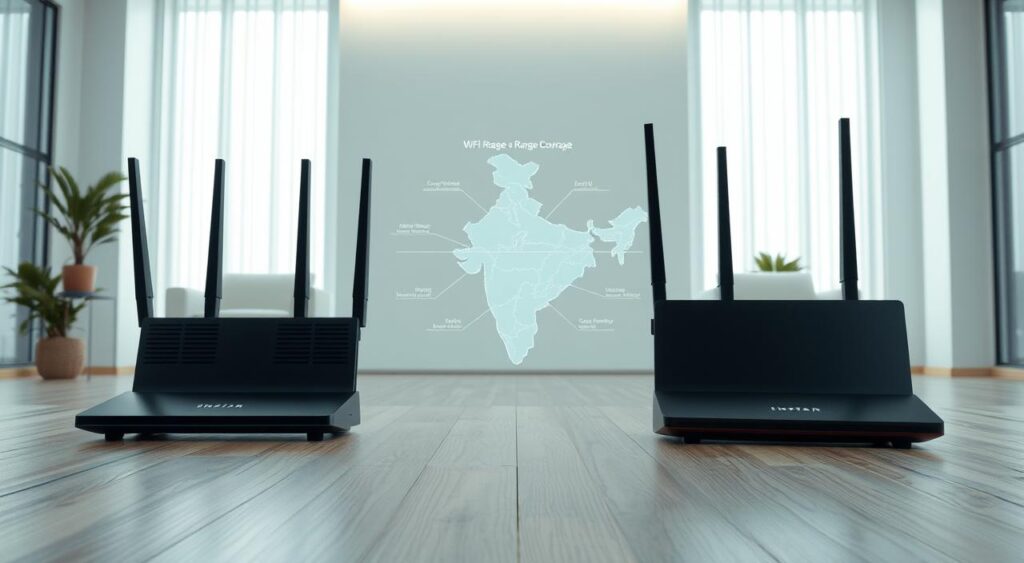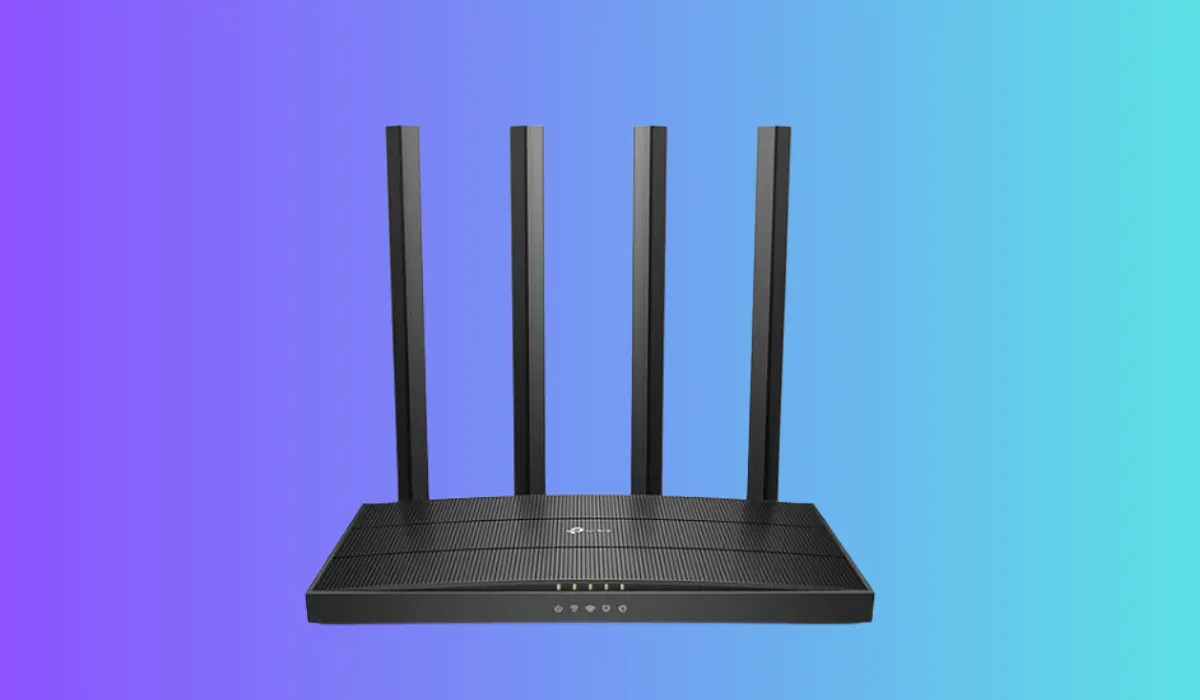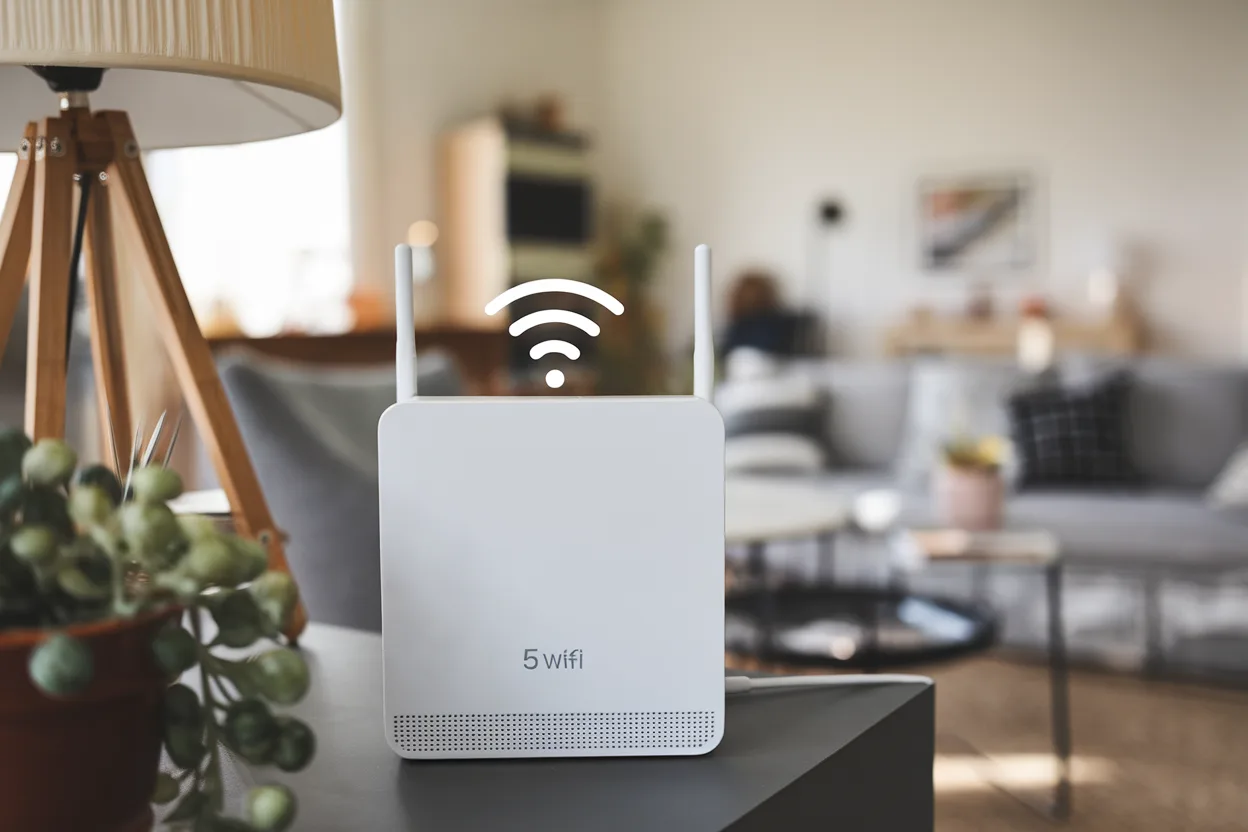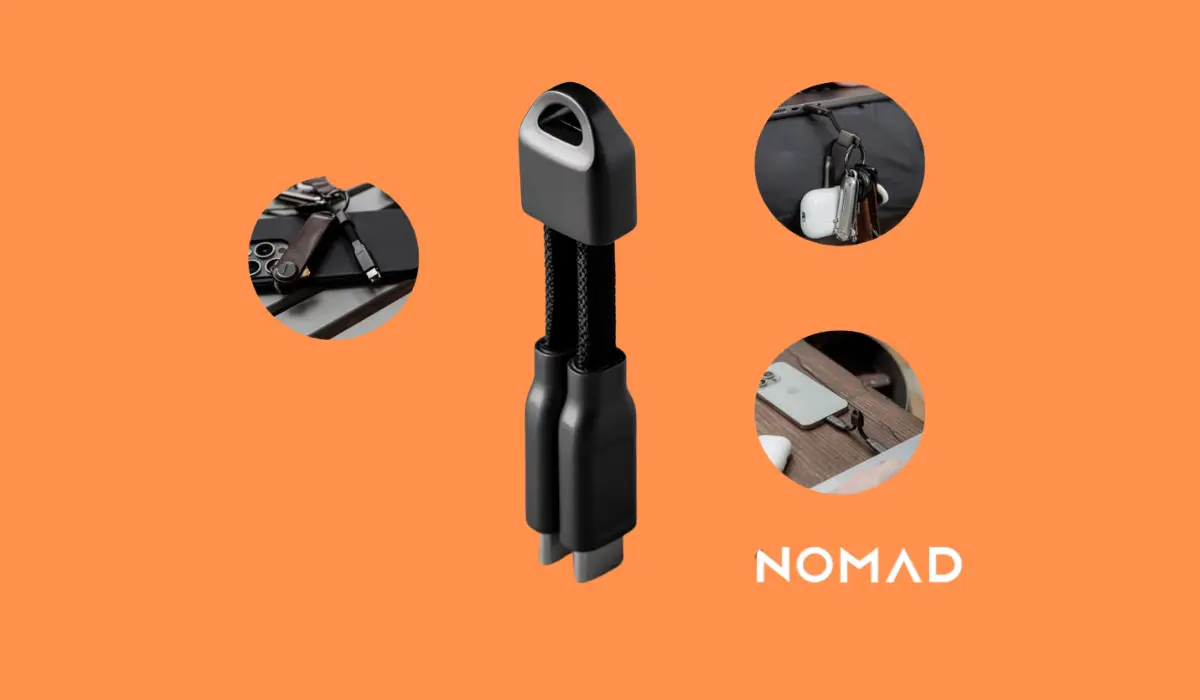Table of Contents
Did you know that many Indian homes face WiFi dead zones? These can cover up to 30% of living spaces. Finding a wifi router with a long range is key for smooth internet access.
TOP 5 Wifi Routers
- AC1200 Dual-Band Wi-Fi —— 867 Mbps at 5 GHz and 400 Mbps at 2.4 GHz band;MU-MIMO Technology —— Simultaneously transfers data to multiple devices for 2× faster performance
- AC 1200 Mbps WAVE 2 Concurrent dual band wireless Router with 4 High gain Omni Antenna
- Super-Fast 1.8 Gbps Wi-Fi —— Enjoy smooth 4K streaming and downloading with super-fast Wi-Fi speeds of 1.8 Gbps.;Connect More Devices —— Communicates with more devices using OFDMA while simultaneously reducing lag.
- AC1200 Dual-Band Wi-Fi —— 867 Mbps at 5 GHz and 400 Mbps at 2.4 GHz band;MU-MIMO Technology —— Simultaneously transfers data to multiple devices for 2× faster performance
- Compliant with 802.11ac Wave 2.0 Standard – Powered by new 802.11ac Wave 2.0 technology, AC5 offers a combined dual band wireless transmission as high as of 1167 Mbps;with the MU-MIMO technology, AC5 can communicate with multiple devices at a time, over 20% faster in internet connection.
Today’s homes and offices need strong WiFi that goes through walls and covers many rooms. The TP-Link Archer AX23 is a top choice. It uses advanced tech to solve connectivity problems.
Understanding WiFi range is complex. It involves signal strength and frequency bands. These factors affect how well a router can reach across different areas.
Key Takeaways
- WiFi range impacts overall internet connectivity experience
- Modern routers offer advanced signal penetration technologies
- TP-Link Archer AX23 represents cutting-edge wireless networking solutions
- Coverage depends on multiple technical and environmental factors
- Choosing the right wifi router can eliminate dead zones
Understanding WiFi Range and Coverage Factors
Looking into home network performance shows us key points about internet and WiFi strength. Wireless networks face many complex factors that affect their performance and reach.
WiFi signals move through different environments, facing unique challenges. Knowing these helps users make their home network better.
Impact of Frequency Bands on Range
WiFi routers use two main frequency bands: 2.4 GHz and 5 GHz. Each band has its own strengths for internet:
- 2.4 GHz: Longer range, better wall penetration
- 5 GHz: Faster speeds, shorter range
Physical Obstacles and Signal Penetration
Various materials can change WiFi signal strength in a home. Concrete walls, metal, and thick floors can cut down wireless coverage a lot.
| Material | Signal Reduction |
|---|---|
| Wooden Walls | 10-20% Signal Loss |
| Concrete Walls | 50-70% Signal Loss |
| Metal Surfaces | 70-90% Signal Loss |
Router Antenna Configuration
Router antennas are key in spreading wireless signals. Omnidirectional antennas send signals in many directions. Directional antennas aim signals at specific spots.
“Strategic antenna placement can improve home network performance by up to 30%.” – Wireless Networking Experts
Choosing the right router and understanding signal movement helps users get strong internet everywhere in their home.
Top Long-Range WiFi Routers in India for 2024
Choosing the right long-range WiFi router boosts your network security and setup. India’s tech market has many great options for strong wireless signals over big areas.

- TP-Link Archer C6 AC1200 Dual Band Router
- D-Link DIR-825 AC1200 Wi-Fi Router
- TP-Link Archer AX23 AX1800 Dual-Band Wi-Fi 6 Router
- Tenda AC5 AC1200 Dual Band WiFi Router
- WAVLINK AC1200 High Power Wireless Router
Let’s look at what makes these routers great for covering your network:
| Router Model | Range Coverage | Network Security Features |
|---|---|---|
| TP-Link Archer C6 | Up to 150 meters | WPA3 encryption |
| D-Link DIR-825 | Up to 180 meters | Advanced firewall protection |
| TP-Link Archer AX23 | Up to 200 meters | Enhanced WiFi security |
| Tenda AC5 | Up to 140 meters | Parental controls |
| WAVLINK AC1200 | Up to 170 meters | Guest network isolation |
Each router has its own benefits for different needs. The TP-Link Archer AX23 is a top pick for its range and security. It ensures reliable connection in many rooms and floors.
When setting up your router, think about signal strength, device compatibility, and coverage needs. The right placement and setup boost your network’s performance.
High-Power Router Technology and Performance Features
Modern WiFi technology has changed how we connect at home and work. The growth of 5g wifi and mesh networks has made internet access better.
Router makers keep pushing the limits with new tech. They aim to boost signal strength and reach. These innovations help solve common connection problems in various settings.
Beamforming Technology: Precision Signal Targeting
Beamforming is a big leap in wireless tech. It lets routers:
- Direct WiFi signals to devices
- Boost signal strength and dependability
- Lessen interference from other networks
- Improve network performance
MU-MIMO Capabilities: Simultaneous Device Support
MU-MIMO tech lets routers talk to many devices at once. It’s key for homes with lots of connected gadgets.
Signal Amplification Systems: Extending Network Range
Signal amplifiers work well with mesh networks for full coverage. They get rid of dead zones and keep connections strong over big areas.
Advanced router technologies are transforming how we experience wireless connectivity in the digital age.
With these advanced features, modern routers offer top-notch performance and reliability for 5g wifi networks.
TP-Link Archer AX23: The Range Champion
The TP-Link Archer AX23 is a top choice for wireless networking. It offers amazing wifi range, pushing past what old routers can do. This router boosts home internet with its WiFi 6 technology.
Here’s why the Archer AX23 is great for those who want strong wireless networking:
- AX1800 dual-band wireless performance
- Enhanced WiFi 6 coverage across larger living spaces
- Reduced need for additional wifi range extender devices
- High-speed data transmission up to 1.8 Gbps
Designed for today’s Indian homes, the Archer AX23 has strong signal strength. It goes through walls and covers many rooms well. Its smart antenna setup keeps the internet strong everywhere in your home.
The router’s advanced technology eliminates dead zones and provides seamless wireless networking experience.
This router’s wifi range extender features are really good. It handles many devices at once without slowing down the internet. You can enjoy smooth streaming, gaming, and work online without any issues.
- Supports 2.4 GHz and 5 GHz bands
- Compatible with latest WiFi 6 standards
- Enhanced security protocols
For those in India looking for top-notch wireless networking, the TP-Link Archer AX23 is a smart choice. It’s a great investment for your home’s internet setup.
Comparing WiFi Router Coverage Areas
Knowing how far WiFi routers can reach is key to a good home network. Different homes and layouts need special internet setups. These setups must handle various space challenges.

Choosing the best router means looking at how it works in different areas. The range and signal strength greatly affect your network’s reliability and internet speed.
Single Floor Coverage Dynamics
Single-floor coverage depends on several things that affect signal spread:
- Square footage of living space
- Wall material composition
- Router antenna configuration
- Frequency band utilization
Multi-Story Performance Challenges
Getting a strong signal on multiple floors is tough. Modern routers use special tech to keep internet strong across floors.
| Router Type | Single Floor Range | Multi-Story Performance |
|---|---|---|
| Budget Routers | 1000-1500 sq ft | Limited penetration |
| Mid-Range Routers | 1500-2500 sq ft | Moderate performance |
| High-End Routers | 2500-3500 sq ft | Excellent coverage |
Outdoor Range Capabilities
Outdoor range depends on the design of external antennas and weather. Weather-resistant routers can reach further than usual.
“Choosing the right router is about understanding your specific spatial requirements.” – Network Engineering Expert
For the best home network, you must look at router specs and your home’s needs carefully.
Best Budget-Friendly Long Range Routers

Finding a cheap wifi router with good range and security is hard. But, there are many great options in India that are both affordable and effective.
The Tenda AC5 AC1200 Dual Band WiFi Router is a top pick for those on a budget. It has great range and strong security features. Plus, it works well with many devices thanks to its dual-band tech.
- Cost-effective wifi router options under ₹2,500
- Reliable network security protocols
- Decent coverage for small to medium-sized homes
- Compatibility with multiple internet service providers
When looking for a cheap wifi router, keep these things in mind:
- Signal strength and range capabilities
- Built-in security features
- Frequency band support
- Number of supported devices
Pro tip: Budget routers can have great security with the right setup and updates.
Smart consumers know that price doesn’t always mean better performance.
Other good choices include the TP-Link TL-WR840N and Netgear R6080. They offer great value without costing too much. They’re perfect for those who want a reliable wifi router without spending a lot.
Advanced Features for Enhanced Coverage
Modern wireless networking has grown beyond basic connections. It now offers advanced technologies that boost WiFi performance and range. These innovations help users build stronger and more efficient home networks.
New routers come with advanced features. These features aim to enhance wireless networking and get rid of dead zones in homes or offices.
Smart Connect Technology
Smart Connect Technology is a big step forward in managing wireless networks. It smartly picks the best frequency band for each device. This ensures:
- Balanced network load distribution
- Improved overall network performance
- Reduced signal congestion
- Seamless device connectivity
Quality of Service (QoS) Optimization
Quality of Service settings let users control network traffic. With QoS, you can:
- Allocate bandwidth for important applications
- Minimize latency for gaming and streaming
- Ensure consistent performance for work-related tasks
WiFi Range Extension Options
Expanding your network’s coverage is now simpler with various wifi range extender options. Users can pick from:
- Mesh WiFi Systems: Offer full coverage in large areas
- Powerline adapters: Send signals through electrical circuits
- Traditional WiFi range extenders: Enhance signals in hard-to-reach spots
By using these advanced features, users can make their wireless networks more reliable and wide-reaching. They can tailor their networks to meet their specific needs.
Setting Up Your WiFi Router for Maximum Range
Getting the best out of your home network starts with setting up your router right. The right setup can make your WiFi reach farther and connect better in your home.
Start by picking the best spot for your router. Put it in the middle of your home, up high, and away from walls. Don’t place it near metal or electronics that can mess with your signal.
- Choose a high, central location
- Keep router away from metal objects
- Minimize obstacles between router and devices
Next, tweak your router’s settings to boost range and speed. Log into your router’s control panel through a web browser. Here, make these key changes:
- Pick the least busy wireless channel to cut down on interference
- Keep your router’s firmware up to date
- Turn on advanced features like beamforming
| Setting | Recommended Configuration |
|---|---|
| Wireless Channel | Choose least congested channel (1, 6, or 11) |
| Frequency Band | Use 5 GHz for shorter range, higher speed |
| Transmit Power | Set to maximum for extended coverage |
Your home network’s performance is all about the router setup. Try different settings to find what works best for your space.
Pro Tip: Use WiFi analyzer apps to find the best channels and reduce signal interference.
Router Placement and Optimization Tips
To get the most out of your internet, you need to set up your router right. Where you put your router and how you set it up matters a lot. Learning the best ways to optimize your router can make your home network work better.
Finding the best spot for your router is key. You want to make sure your signal reaches every corner of your space.
Ideal Mounting Locations
- Put your router in a central, high spot
- Avoid putting it on the floor
- Keep it away from walls and metal things
- Place it at chest level for the best coverage
Signal Interference Prevention
Many things can mess with your wireless network. Knowing what can cause problems helps keep your internet stable.
- Find out what might interfere with your signal:
- Microwave ovens
- Cordless phones
- Bluetooth devices
- Thick concrete walls
- Keep your router at least 3-5 feet away from these things
- Use the 5GHz frequency for clearer signals
Channel Selection Guidelines
Picking the right WiFi channel can really boost your network’s speed. It also helps avoid signal jams.
| Frequency Band | Recommended Channels | Performance Impact |
|---|---|---|
| 2.4 GHz | Channels 1, 6, 11 | Minimal Interference |
| 5 GHz | Channels 36, 40, 44, 48 | Higher Speed |
Pro tip: Check and change your router’s channel often to keep your network running smoothly.
Conclusion
Finding the right long-range WiFi router can be tricky. But knowing what to look for makes it easier. The best router makes your home network strong, giving you smooth internet everywhere.
Look for a router with good range, strong signal, and features like beamforming and MU-MIMO. TP-Link, Netgear, and Asus have great options for India. Think about what you need for your home to pick the best one.
Where and how you set up your router matters a lot. Consider obstacles, frequency, and interference to get the best signal. Proper setup is key to a great home network.
Technology changes fast, so keep up with new router features. Choose well, set up right, and enjoy fast internet at home.
FAQ
What factors affect WiFi router range?
Several factors impact WiFi router range. These include frequency bands, physical obstacles, and router technology. The 2.4 GHz band offers better range and penetration through walls. On the other hand, 5 GHz provides faster speeds over shorter distances.
Physical barriers like concrete walls and metal objects can reduce signal strength. Technologies like beamforming and MU-MIMO can help extend and optimize WiFi coverage.
How can I improve my WiFi router’s range?
To improve WiFi range, try these tips: – Place your router in a central location – Minimize physical obstacles – Update router firmware – Use WiFi range extenders – Consider a mesh network system – Adjust router antenna positioning – Select less congested WiFi channels – Upgrade to a modern router with advanced range technologies
What is the best budget-friendly long-range router?
The Tenda AC5 AC1200 Dual Band WiFi Router is a great choice. It offers good coverage and dual-band support at an affordable price. Other budget-friendly options include the TP-Link Archer C6 and some D-Link models.
How do I choose the right WiFi router for my home?
When choosing a WiFi router, consider several factors. These include home size and layout, number of devices, and internet usage. Also, think about your budget, WiFi 6 compatibility, range capabilities, and security features.
What is the difference between 2.4 GHz and 5 GHz WiFi bands?
The main differences are: – 2.4 GHz has a longer range and better wall penetration but is more crowded. – 5 GHz offers faster speeds but has a shorter range and less interference. – 2.4 GHz is better for larger homes and multiple obstacles. – 5 GHz is ideal for short-range, high-speed connections. – Many routers offer dual-band functionality to use both frequencies.
How can I protect my home WiFi network?
To protect your home WiFi network, use a strong, unique password and enable WPA3 encryption. Update your router firmware regularly and disable remote management. Create a guest network and use a firewall.
What are mesh network systems?
Mesh network systems use multiple nodes to create a wide-reaching network. They offer consistent coverage, eliminate dead zones, and automatically route traffic. They’re great for large areas and multi-story homes.
How often should I replace my WiFi router?
Replace your WiFi router every 3-5 years or when needed. Consider replacing it if you’re experiencing performance issues or need WiFi 6 technology. Also, replace it if your router doesn’t support modern security features or if your internet speeds have improved.












